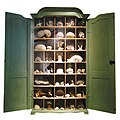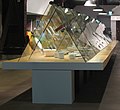Portal:Museums
The Museums Portal
A museum (/mjuːˈziːəm/ mew-ZEE-əm) is an institution dedicated to displaying and/or preserving culturally or scientifically significant objects. Many museums have exhibitions of these objects on public display, and some have private collections that are used by researchers and specialists. Compared to a library, a museum hosts a much wider range of objects and usually focus around a specific theme such as the arts, science, natural history, local history, and other topics. Public museums that host exhibitions and interactive demonstrations are often considered to be tourist attractions, and many museums attract large numbers of visitors from outside their host country, with the most visited museums in the world regularly attracting millions of visitors annually.
Since the establishment of the earliest known museum in ancient times, museums have been associated with academia and the preservation of rare items. Museums originated as private collections of interesting items, and not until much later did the emphasis on educating the public take root. (Full article...)
Selected museum

The National September 11 Memorial & Museum (also known as the 9/11 Memorial & Museum) is a memorial and museum that are part of the World Trade Center complex, in New York City, created for remembering the September 11 attacks of 2001, which killed 2,977 people, and the 1993 World Trade Center bombing, which killed six. The memorial is located at the World Trade Center site, the former location of the Twin Towers that were destroyed during the September 11 attacks. It is operated by a non-profit institution whose mission is to raise funds to program and operate the memorial and museum at the World Trade Center site.
A memorial was planned in the immediate aftermath of the attacks and destruction of the World Trade Center for the victims and those involved in rescue and recovery operations. The winner of the World Trade Center Site Memorial Competition was Israeli-American architect Michael Arad of Handel Architects, a New York City and San Francisco-based firm. Arad worked with landscape-architecture firm Peter Walker and Partners on the design, creating a forest of swamp white oak trees with two square reflecting pools in the center marking where the Twin Towers stood.
In August 2006, the World Trade Center Memorial Foundation and the Port Authority of New York and New Jersey began heavy construction on the memorial and museum. The design is consistent with the original master plan by Daniel Libeskind, which called for the memorial to be 30 feet (9.1 m) below street level—originally 70 feet (21 m)—in a plaza, and was the only finalist to disregard Libeskind's requirement that the buildings overhang the footprints of the Twin Towers. The World Trade Center Memorial Foundation was renamed the National September 11 Memorial & Museum in 2007.
A dedication ceremony commemorating the tenth anniversary of the attacks was held at the memorial on September 11, 2011, and it opened to the public the following day. The museum was dedicated on May 15, 2014, with remarks from Mayor of New York City Michael Bloomberg and President Barack Obama. Six days later, the museum opened to the public. (Full article...)
Selected interior image
Selected general article
Museum architecture has been of increasing importance over the centuries, especially more recently.
A challenge for museum architecture is the differing purposes of the building. The museum collection must be preserved, but it also needs to be made accessible to the public. Climate control may be very important for the objects in the collection. (Full article...)
Did you know...
- ... that landscape architect Harriet Pattison collaborated with her lover Louis Kahn on the design of Four Freedoms Park and the grounds of the Kimbell Art Museum?
- ... that Kobe and Vanessa Bryant were founding donors of the National Museum of African American History and Culture?
- ... that One Night with Regine was a concert in support of the child-welfare program Bantay Bata, staged on the steps of the entrance façade of the National Museum of Anthropology in Manila?
- ... that Jäñgir-Kerei Khan was responsible for establishing the first school, settlement, hospital, and museum in the Bukey Horde?
- ... that Sheikh Mujibur Rahman proclaimed the independence of Bangladesh from his residence in Dhaka before his arrest by the Pakistan Army?
- ... that the James Norman Hall Museum is where the The Bounty Trilogy was written?
Get involved
For editor resources and to collaborate with other editors on improving Wikipedia's Museums-related articles, see WikiProject Museums.
Selected exterior image
Selected type of museum

Cabinets of curiosities (German: Kunstkammer and Kunstkabinett), also known as wonder-rooms (German: Wunderkammer), were encyclopedic collections of objects whose categorical boundaries were, in Renaissance Europe, yet to be defined. Although more rudimentary collections had preceded them, the classic cabinets of curiosities emerged in the sixteenth century. The term cabinet originally described a room rather than a piece of furniture. Modern terminology would categorize the objects included as belonging to natural history (sometimes faked), geology, ethnography, archaeology, religious or historical relics, works of art (including cabinet paintings), and antiquities. In addition to the most famous and best documented cabinets of rulers and aristocrats, members of the merchant class and early practitioners of science in Europe formed collections that were precursors to museums.
Cabinets of curiosities served not only as collections to reflect the particular curiosities of their curators but also as social devices to establish and uphold rank in society. There are said to be two main types of cabinets. As R. J. W. Evans notes, there could be "the princely cabinet, serving a largely representational function, and dominated by aesthetic concerns and a marked predilection for the exotic," or the less grandiose, "the more modest collection of the humanist scholar or virtuoso, which served more practical and scientific purposes." Evans goes on to explain that "no clear distinction existed between the two categories: all collecting was marked by curiosity, shading into credulity, and by some sort of universal underlying design". (Full article...)
In the news
- 12 May 2024 –
- Forty-nine Vatican Museums employees start an unprecedented labor dispute over unfair and poor working conditions against the Vatican's Pontifical Commission. (Reuters)
- 6 May 2024 –
- The 2024 Met Gala takes place at the Metropolitan Museum of Art in New York City with the theme "The Garden of Time", celebrating the Met's exhibit Sleeping Beauties: Reawakening Fashion. (Vanity Fair)
Subcategories
Subtopics
Lists
- Museums
- Most visited museums (by region)
- Art museums: most visited, largest
Types
- Art museum
- Agricultural museum
- Archaeology museum
- Architecture museum
- Artillery museum
- Aviation museum
- Biographical museum
- Cabinet of curiosities
- Ceramics museum
- Children's museum
- Community museum
- Computer museum
- Design museum
- Dime museum
- Ecomuseum
- Economuseum
- Ethnographic village
- Farm museum
- Fashion museum
- Folk museum
- Food museum
- Green museum
- Hair museum
- Hall of Memory
- Heritage centre
- Historic house museum
- Human rights museum
- Imaginarium
- Interpretation centre
- Jewish museum
- Lapidarium
- Lighthouse museum
- Living museum
- Local museum
- Maritime museum
- Migration museum
- Mobile museum
- Museum ship
- National history museum
- Natural history museum
- Open-air museum
- Palace museum
- Postal museum
- Prefectural museum
- Print room
- Private museum
- Regimental museum
- Schatzkammer
- Science fiction libraries and museums
- Science museum
- Sex museum
- Sculpture garden
- Technology museum
- Textile museum
- Torture museum
- Toy museum
- Transport museum (list)
- University museum
- Virtual museum
- Wax museum
- Writer's home
Related
Associated Wikimedia
The following Wikimedia Foundation sister projects provide more on this subject:
-
Commons
Free media repository -
Wikibooks
Free textbooks and manuals -
Wikidata
Free knowledge base -
Wikinews
Free-content news -
Wikiquote
Collection of quotations -
Wikisource
Free-content library -
Wikiversity
Free learning tools -
Wiktionary
Dictionary and thesaurus






































































